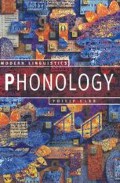Abstract
We begin by examining, in Sections 11.1 and 11.2, the claim that segments are better characterised as having more internal structure than that allowed for in standard GP representations. In Section 11.2, we will see how autosegmental representations can be extended to express this idea, and how they can be tied into the idea of a tier consisting of a set of timing slots (as in the CV tier). In Sections 11.3–11.5, we look at three theories which claim that all phonological oppositions are privative.1 The theory presented in Section 11.4 combines this notion with the idea of government between phonological units and the idea of tier structure introduced in Section 11.2. The final section, Section 11.5, presents a privative theory which incorporates the bold claim that rules are dispensable in phonology.
Preview
Unable to display preview. Download preview PDF.
Copyright information
© 1993 Philip Carr
About this chapter
Cite this chapter
Carr, P. (1993). Representations and the Role of Rules. In: Phonology. Modern Linguistics Series. Palgrave, London. https://doi.org/10.1007/978-1-349-22849-2_12
Download citation
DOI: https://doi.org/10.1007/978-1-349-22849-2_12
Publisher Name: Palgrave, London
Print ISBN: 978-0-333-51908-0
Online ISBN: 978-1-349-22849-2
eBook Packages: Palgrave Social & Cultural Studies CollectionSocial Sciences (R0)

